Grand Stade de Tanger
| Capacity | 75 600 |
|---|---|
| Country | Morocco |
| City | Tangier |
| Clubs | Ittihad de Tanger |
| Other names | Stade Ibn Batouta |
| Inauguration | 14/11/2025 |
| Construction | 2023–2025 |
| Design | Cabinet d'Architecture Amaoui Anouar Gueriri |
Advertisement
Grand Stade de Tanger – stadium description
What is Grand Stade de Tanger like in brief?
Grand Stade de Tanger was originally built with an athletics track and opened in April 2011, after nearly 10 years of construction. The first expansion took place between 2020 and 2023, when the stands on the curves were extended, increasing the capacity from 45,000 to 65,000 spectators.
The renovation was then continued in a second phase from 2023 to 2025. The athletics track was removed, the stands were expanded by an additional 10,000 seats, the facade was completed, and a new roof was added over the entire seating area.
This gave the stadium a complete transformation, turning it into a high-standard, football-specific arena. The “new” Grand Stade de Tanger was inaugurated on 14 November 2025 with a friendly match between Morocco and Mozambique.
Grand Stade (“Great Stadium”) is truly enormous – it is the largest building in the city in terms of footprint. With a capacity exceeding 75,000, it is currently the largest stadium in the country, although it is set to be surpassed by the massive Stade Hassan II under construction near Casablanca.
The stadium serves as the home of the local team, Ittihad Riadi de Tanger, but it was built with the aim of hosting major events, particularly the 2025 Africa Cup of Nations and prestigious matches of the 2030 World Cup.
What did Grand Stade de Tanger look like before the 2023–2025 expansion?
The large stadium in Tangier was originally a multi-purpose venue with an athletics track, inaugurated in April 2011. Between 2020 and 2023, the first expansion was carried out, extending the curves and raising the capacity from 45,000 to 65,000 seats.
The former configuration of Grand Stade de Tanger with the athletics track (up to 2023) is shown on a separate page
How was the “new” Grand Stade de Tanger created?
During the works in 2020–2023, it was decided to revise the plans and expand the scope of the renovation. The next phase included removing the athletics track, lowering the pitch, and adding a new lower-tier of stands close to the field, in order to transform the stadium into a football-specific venue.
The new plan also provided for a new roof covering all the stands, completing the facade, and modernizing and refurbishing the entire stadium. The expansion was designed by Cabinet d'Architecture Amaoui Anouar Gueriri.
How was the Grand Stade de Tanger expansion linked to the World Cup?
The increased scope of the renovation was related to Morocco’s efforts to host major international events, including the 2030 World Cup. These efforts were successful, and in October 2023, Morocco was announced as a co-host of the 2030 World Cup. Slightly earlier, Morocco was also awarded the 2025 Africa Cup of Nations, with the Tangier stadium set to host matches in both tournaments.
When was the “new” Grand Stade de Tanger completed?
The second phase of the project began in the summer of 2023. The expansion was completed in autumn 2025, and the “new” Grand Stade de Tanger was inaugurated on 14 November 2025, on the occasion of a friendly match between Morocco and Mozambique (1–0), just over a month before the start of the 2025 Africa Cup of Nations.
This second phase gave the stadium a completely new appearance. The arena was transformed into a football-specific venue, and the decorative facade, full roof coverage, and renovated stands completely changed its look. With a capacity of over 75,000 spectators, the stadium became the largest in the country, although it is expected to be surpassed by the massive Stade Hassan II under construction near Casablanca.
What does Grand Stade de Tanger look like?
Grand Stade de Tanger has a capacity of 75,000 spectators, making it the largest stadium in Morocco. The venue features VIP boxes and hospitality areas, and the seats in the stands are white, grey, and blue.
The stands are divided into three tiers, with the older upper and middle tiers retaining their original shape from the time when the stadium had an athletics track. Behind the goals, these tiers therefore form sharply curved arcs and are set significantly further from the pitch.
The seating area is covered by a membrane roof, under which lighting and sound systems, as well as video screens, are suspended.
On the exterior, the stands are protected by a decorative facade, whose continuity is “interrupted” by three-dimensional reinforced concrete pillar-beam structures at the main entrances and spiral staircases. Large screens adorn the facade along the curves. At night, the stadium can be illuminated in different colors.
Where is Grand Stade de Tanger located?
The stadium is situated on the southwestern outskirts of the city, about 7 km from the center, along the main road (N1) leading south and towards the airport.
It forms the centerpiece of a larger sports complex, which also includes an Olympic swimming pool, a tennis complex, a multi-purpose sports hall, a smaller football stadium, a training track, and even a covered pétanque court.
What events take place at Grand Stade de Tanger?
The local football club, Ittihad Riadi de Tanger, plays its home matches at the stadium. However, the venue was built as a representative arena for the entire city of Tangier and is intended to host various high-level sporting and cultural events.
In particular, the stadium has been prepared to host matches as part of the 2025 Africa Cup of Nations and the 2030 World Cup. The World Cup, especially, carries great significance, highlighting the stadium’s prestige and status as one of the most important football venues in Morocco and across Africa.
What is the stadium in Tangier called?
The stadium is referred to as Grand Stade de Tanger (“Great Stadium of Tangier”), but it is also known as Stade Ibn Batouta, in honour of the greatest Arab traveller of the Middle Ages, who was born in Tangier.
Advertisement
Pictures
-
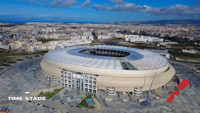
02.11.2025 © TIME-STADE 
02.11.2025 © TIME-STADE 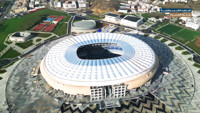
11.2025 © SONARGES 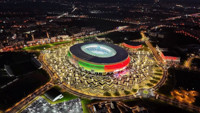
14.11.2025 © Équipe du Maroc 
14.11.2025 © Équipe du Maroc 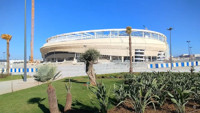
21.07.2025 © Jihad el andalussi 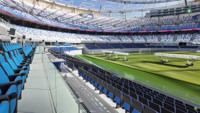
20.09.2025 © Fédération Royale Marocaine de Football 
20.09.2025 © Fédération Royale Marocaine de Football 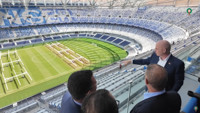
20.09.2025 © Fédération Royale Marocaine de Football 
11.2025 © SONARGES 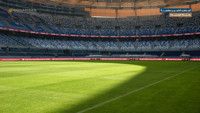
11.2025 © SONARGES 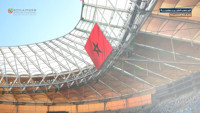
11.2025 © SONARGES 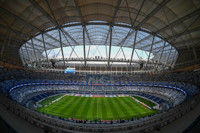
14.11.2025 © TotalEnergies Africa Cup of Nations 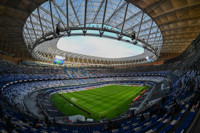
14.11.2025 © TotalEnergies Africa Cup of Nations

 StadiumDB
StadiumDB